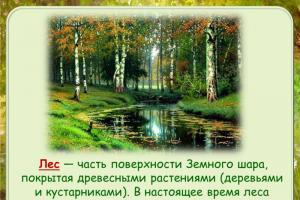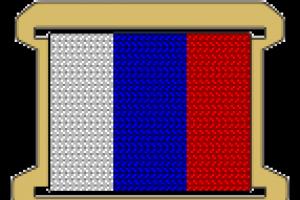- Preservation of water in the soil - much less moisture evaporates from the covered surface, eliminating the need for frequent watering;
- Temperature regulation - on hot days the root system will not overheat, and in winter it will not freeze;
- Restraining the growth of weeds - mulching with a layer 4–6 cm thick prevents the appearance of unnecessary plants;
- Soil improvement – closed ground remains loose longer, permeable to air and water;
- Nutrient enrichment - organic mulch decomposes over time, saturating the soil with useful components;
- Regulating the acidity level - introduced pine needles, cones, bark or spruce branches gradually acidify the soil;
- Decoration of the site - mulch under the trees looks neat, which means the decorativeness of the garden increases.
What can be used for mulching?
You don’t have to go to the store; suitable materials for mulching can be on your property or in a nearby forest. Let's consider available options DIY mulch.
Dry leaves
A natural material found almost everywhere. Fallen leaves are collected in your own garden or in the nearest forest belt, then poured around the trunks in a layer of about 5 cm. The “coat” created in this way perfectly protects the rhizomes from frost.

Coniferous plants love acidified soils, which is favored by spruce and pine sawdust or shavings added under them. Large wood waste traps snow, providing additional cover. Before mulching, the soil is enriched with nitrogen fertilizers.

The surface covered with ordinary pine cones, which were previously lying around uselessly. Any synthetic fabric is placed under this mulch to control weeds. If you don’t walk on the cones, they will lie intact for quite a long time. Similarly, the bark of coniferous trees is used, which is sold in many nurseries.
Conifer needles

Buying bark in bags is quite expensive, so for mass covering it is easier to collect the top layer of half-ripened needles from the forest. A thin layer should be raked so as not to harm the trees. The “spiny” layer protects the soil well, and small rodents and slugs do not like such shelter.
Gravel, stone or expanded clay

Mulching with pebbles or stone chips solves several problems: it keeps moisture in the ground, protects against overheating, prevents the growth of weeds and plays an aesthetic role. Inorganic materials do not rot, so they retain their original appearance for decades.
Dry branches

Even in a small garden, some branches are constantly being cut off. Usually they are burned, but if they are taken from healthy plants, then it is more advisable not to throw them away, but to cut them into small pieces with pruning shears and use them as a mulching component for coniferous plantings.
How are coniferous plantings mulched?

The branches of plants located close to the ground are lifted or tied, so they will not be damaged, and it will be more convenient to work. The boundaries of the area to be covered are outlined, and the turf is removed. Trying not to tear the rhizome, the soil around the trunk is carefully removed with a loosening tool to a depth of 5–10 cm. The soil is dug at a distance of a meter or more from the trunk, starting from the far border and, moving closer to the plant, stopping plowing when surface roots appear.
The soil can be fertilized with mineral supplements or organic ones, for example, clover with pine needles. The surface is leveled and compacted, then mulch is laid out in an even layer.
The mulching methods discussed are simple and can be used by most gardeners. The choice of a specific option depends on availability - why spend money when the suitable material is available near your garden.
To improve soil characteristics and maintain quality composition soil is used tree mulching. This procedure not only protects the soil from the sun (prevents crust formation), but also keeps moisture from evaporating.
We offer professional gardening work. Our experienced specialists will carry out: mulching, fertilizing the garden, spraying, and combat any insects and diseases. Many years of experience, skillful hands and specialized equipment - these are the three pillars on which our work is based! :)
Why mulch the soil?
First, let's figure it out what is tree mulching and why use it in garden plots. Essentially, mulching is covering the soil with special materials (mulch). All materials are divided into two groups: organic and inorganic.
Organic matter includes: wood waste (sawdust, bark, shavings), plants (freshly cut grass, straw, hay, nettles), as well as moss and pine needles. Popular inorganic mulch: paper (newsprint, cardboard), film (black, red - a foreign novelty, transparent - rarely used).
Mulching fruit trees performs the following functions:
- Insulation of the root system (the soil does not freeze);
- Reflection of sunlight (if light mulch is used);
- Retaining moisture, preventing rapid evaporation;
- Weed control (they do not grow through coatings);
- Ensures soil looseness is maintained.
Experienced gardeners note that in mulched lands, trees develop more adventitious roots, which has a positive effect on their development.
So let's consider how to properly mulch trees to achieve maximum results. Since mulch will serve as a shield from environment, before covering the soil, it is advisable to add useful microelements to it and saturate it with organic matter. It is especially important to fertilize the plants if you plan to cover the soil with inorganic materials. It is necessary to cover all the tree trunk circles with mulch.
Organic coating layer thickness:
- Straw, hay, freshly cut grass – 10-15 cm;
- Nettle (finely crushed) – 5 cm;
- Sawdust – about 7 cm;
- Bark for mulching trees - from 5 cm or more;
- Moss - about 10 cm.
- Needles (rotten) – 3-5 cm.
Almost all inorganic mulch is laid in one layer (all types of film and cardboard); newsprint is laid in several layers (minimum 4). Unlike artificial turf, organic matter lasts less, but as it decomposes, it saturates the soil with useful microelements.
Let us remind you that our professional gardeners will help you mulch your garden. We will complete all work as quickly, efficiently and inexpensively as possible! :)
Peculiarities different types mulch
- Suitable for protection against severe overheating of the soil mulching trees with sawdust or other light materials. Like a mirror they reflect Sun rays. In addition, moisture practically does not evaporate from under the material even on hot days.
- To saturate the earth with useful microelements, you can use mulching garden trees nettle. It decomposes quickly and contains nitrogen, which has a positive effect on tree growth. Freshly cut grass is also useful, but unlike nettle, it takes a little longer to break down into useful substances.
- Mulching with tree bark used to retain moisture and decorative purposes. It practically does not “exterminate” weeds; harmful plants grow quietly through a 3-4 cm layer of bark. Straw or hay, as well as artificial mulch, will help to overcome weeds.
- It is better to mulch trees for the winter with moss. It retains heat well, which is why moss is often used in intensive gardens, that is, areas planted with columnar trees. Thanks to the heat retention by moss, the ground practically does not freeze, which is very important for all plants with a root system close to the soil surface.
- Inorganic mulch Most often used for vapor protection. As insulation will do perhaps cardboard or roofing felt (they often replace film).
Common parsnip, or field parsnip, or field parsnip (Pastinaca sativa) in the wild is widespread in regions with a temperate climate (central Russia, the North Caucasus, Crimea, the Urals, Altai, etc.), but is still rarely found in garden plots. True, today the popularity of parsnips is growing quite actively. In animal husbandry and beekeeping it is used as a fodder plant and honey plant, and in cooking as a tasty and healthy vegetable.
A universal favorite among decorative deciduous perennials, the hosta captivates not only with the beauty of its leaves. It is durable and relatively undemanding, in right place has been growing for many years, but it can hardly be called fast-growing. Hosta propagates easily, although to obtain spectacular, highly decorative bushes you will have to be patient. To independently increase your hosta collection, first of all, you need to remember the characteristics of this culture.
Dill spreads well by self-sowing, so many summer residents do not consider it necessary to sow this crop every year on their site. But everyone understands that dill and dill are different. And the greens of carefully grown dill in the garden in their own way taste qualities and the aroma, as a rule, is superior to dill, which grows on its own. In this article we will tell you how to have green dill in your garden beds in sufficient quantities from early spring to late autumn.
Stir-fry with beef, soy noodles, vegetables and Iceberg salad - a recipe for a quick dinner or lunch for busy man. It takes no more than 15 minutes to prepare, and you can feed it to a couple of hungry mouths that can’t bear to wait for a fancy lunch. Stir-fry is a method of quickly frying vegetables and meat that came to us from the east. Don't be upset if you don't have a wok. kitchen utensils. A regular frying pan with a thick bottom and non-stick coating will do too.
Among plants that boast variegated foliage, alpinia claims to be not only the rarest, but also the most original crop. It simultaneously reminds of bamboos and calathea arrowroots, and sometimes even of vriesea. True, it resembles the latter only in its inflorescences. Luxurious leaves, most often covered with variegated contrasting stripes, look so modern that it is impossible not to admire the beauty of their impeccable patterns and shine.
Vegetarian cabbage rolls from savoy cabbage with mushrooms - steamed cabbage rolls for dietary, vegetarian and lenten menus. Stuffed cabbage rolls are incredibly tasty, very appetizing, and, if applicable to food, beautiful, unlike their counterparts from white cabbage, stewed in a Dutch oven or fried in a frying pan. Savoy cabbage is tastier than white cabbage, the head is loose, it is easier to separate it into individual leaves. The color of the leaves ranges from soft green to emerald.
IN winter time Every summer resident is looking forward to spring and is happy to open the season with the first plantings of flowers and vegetable crops for seedlings. But, unfortunately, the space on the windowsill is limited, and it is not always possible to place the required number of seedlings in cups in the apartment. In addition, some of the crops may simply not grow, some will die... And for us, summer residents, no matter how much we plant, it’s not enough! Therefore, almost every gardener buys at least some seedlings.
Growing annuals in the garden has at least two advantages over growing perennial flowers. Firstly, most popular annual plants bloom profusely throughout the growing season. Secondly, many annuals sow freely and appear in the garden year after year with minimal participation from the grower. Which annuals can be planted only once, and then, following simple techniques, can be seen in the garden every season?
You can make jellied meat and meat salad with onions from pork knuckle. The shank, especially the hind shank, is a very tasty and affordable part of the pork carcass that can feed a small company. A 2-kilogram shank will yield a bowl of meat salad and a large plate of jellied meat. There will still be some meat broth left over, which I advise you to use to cook cabbage soup or borscht. For this dish, we take a hind shank weighing from 1.7 to 2 kilograms; I advise you to ask the butcher for the meatiest one.
Eggplants require sunny but short days, medium-warm temperatures without sweltering heat, sufficient moisture, but without flooding the root system. Provide such conditions in open ground Most regions of Russia are quite difficult. Therefore, previously eggplants were grown only in protected soil conditions. With the development of selection, it became possible to grow eggplants in open ground not only in the southern regions, but also in middle lane.
Among predator plants, the sundew rightly claims to be the brightest and most expressive beauty. This plant attracts, first of all, its unusual textures and play of colors. But the feeding mechanism of this swamp and quite hardy miracle is so exotic that it is very easy to forget about sundews as plants, primarily ornamental ones. Sundews are quite demanding when it comes to humidity, but they are not that difficult to grow in ordinary living spaces.
Chocolate cake with custard made from simple and affordable ingredients turns out to be so delicious that rarely anyone limits themselves to one piece. The sponge cakes are moist and feel like they are made from real dark chocolate, even though the recipe only calls for cocoa powder. The creamy custard is delicate and light and goes well with chocolate sponge cake. All this splendor of tastes complements coconut flakes, the ingredient is simple, but in this recipe, it’s like a cherry on the cake.
Although the calendar spring begins in March, it is very difficult to call this month spring. But May is already a real long-awaited spring, filled with aromas and the multicolor of awakened nature. Fresh young leaves on trees and bushes attract the eye, yearning for greenery during the long months of winter. In May, the parade of primroses continues in the garden, delighting with variegated foliage and flowering ornamental shrubs, perennials, conifers are renewed.
In the middle zone, the formation of grapes suggests the possibility of shelter for the winter period, which means that the focus should be on keeping the head of the bush at soil level. Even further north on big harvest there is no need to count, but for such areas there are also pruning principles. The article discusses the sleeve-fan scheme for forming a grape bush, often used in the middle zone, and the cordon scheme, which has shown itself well in regions with a more severe climate.
Beef with eggplants with vegetable sauce in the oven is a simple, very tasty and not very high-calorie dish, which is quite relevant nowadays. The sauce is made from vegetables only, no flour, sugar, milk or cream. The meat is without fat, and yet it turns out juicy and tender. Can be replaced with chicken fillet or veal. The eggplants do not need to be fried first, just add a little salt to make them soft. TO ready-made dish I recommend making a light yogurt sauce.
 Before the onset of cold weather, every gardener thinks about how to properly prepare their plot for winter. After all, each individual plant needs appropriate care, and its adequate organization is the primary task of the economic farmer. Extremely important role Proper insulation of trees, which may suffer from frost, strong winds and temperature changes, plays a role. Let's talk on the www.site about how to prepare the tree trunks of fruit trees for the winter, and also answer the question: mulching the soil - what is it?
Before the onset of cold weather, every gardener thinks about how to properly prepare their plot for winter. After all, each individual plant needs appropriate care, and its adequate organization is the primary task of the economic farmer. Extremely important role Proper insulation of trees, which may suffer from frost, strong winds and temperature changes, plays a role. Let's talk on the www.site about how to prepare the tree trunks of fruit trees for the winter, and also answer the question: mulching the soil - what is it?
In order for fruit trees to successfully survive the winter, something needs to be done. Trees must be treated with special preventive solutions, the tree trunk area should also be mulched and small fences should be built near the trees. Today the topic of our conversation will be the preparation of the tree trunk circle itself.
Preparing the tree trunk for winter
Before proceeding directly to insulating tree trunks, it is worth eliminating all weeds around them. Next, you need to dig up the soil ten to fifteen centimeters deep, otherwise the weeds may well germinate in the spring. Also, such digging will help destroy the roots that are close to the surface, through which frost can go deeper. Then preventive treatment of tree trunks and skeletal branches with protective solutions is carried out.
Mulching tree trunk circles trees
The most effective method for preserving trees in winter is considered to be mulching - covering the surface of the soil near plants with a variety of materials that can regulate water and air conditions in the most upper layers soil. In winter, mulch helps reduce the depth of soil freezing. At other times of the year, such material makes it possible to retain moisture, avoid the appearance of weeds, saturate the soil with nutrients and ensure long-term looseness of the soil.
Mulch or mulching material in general can be divided into two main groups, namely permanent and dynamic. The first group can include stone chips, gravel, as well as glass and other similar materials. They, it must be admitted, are characterized by more decorative qualities, although they help somewhat protect the soil. The second group is represented by leaves, peat, hay, bark (ground), sawdust, compost, etc. Such mulch can not only protect the soil, but also effectively enrich it with useful particles.
Manure and humus can be used to cover the trunk circles around trees. Also, many gardeners use spruce branches and burlap, matting and synthetic covering materials such as lutrasil, spunbond, etc. for this purpose. Many mulching materials can be found on the open market.
Mulching trees for the winter can be done with moss. This material is able to retain heat, so it is often used in intensive gardens. Since moss retains heat, the soil underneath practically does not freeze, which is especially important for all crops with a root system located close to the surface of the earth.
After the earthen circle near the fruit trees is treated with a fungicide, it is covered with a layer of mulch of eight to ten centimeters. If you prefer to use humus and compost, the soil layer can be made thinner - about five to seven centimeters, otherwise such materials may simply rot. During severe frosts, experts strongly advise covering the layer of mulch with spruce branches or sprinkling it with snow to a height of up to one meter.
The most simple material For mulching it is worth recognizing the foliage. It perfectly helps protect perennial trees from frosts down to -30C. It is recommended to cover the root zone with leaves that have fallen from trees (exceptionally healthy ones) to a layer of twenty to thirty centimeters. Another advantage of this material is its ability to retain snow (spruce branches, etc., also have these properties).
To insulate the tree trunk for the winter, materials such as felt, straw or reeds can be used. But they are most often used for wrapping the tree trunk of young fruit trees. Burlap is wound over such material, and such a winding is secured with a rope.
Additional Information
If you are going to mulch the tree trunk with sawdust for the winter, think about their origin. If such material came from furniture shops, then it may contain a lot chemical substances. And sawdust from coniferous species trees are a source of many elements that can destroy microflora and suppress the development of other plants.
Do not forget that preparing fruit trees for winter may also include insulating the tree trunks. Such manipulation will be especially necessary for young trees, whose age does not reach five years, because they are still very sensitive to frost. Such crops may need protection with spruce branches, straw, felt, burlap, matting or various synthetic materials - special agrofibre (lutrasil or spabond).
Proper insulation the trunk circle of fruit trees will help such crops survive even the most severe frosts without loss.
Which perennial flowers, trees and shrubs need to be mulched around the trunks with the onset of cold weather? What is this connected with? What material is better to use? What layer thickness should it be? What to do to prevent the wind from blowing the mulch away?
Zinaida Zueva, Leningrad region.
When we plant plants, we try to keep the soil around us free of weeds. But in this case, during the cold season, the plants will not have any insulation. Mulch is precisely designed to protect plants in winter, as it reduces heat exchange between the soil and the atmosphere.
Young seedlings of fruit trees and berry bushes, whose root system is shallow (currants, gooseberries, raspberries, sea buckthorn).
It would also be useful to mulch recently planted or rare varieties of most types of spruce, willow, bird cherry, serviceberry, maple (riverine, silver, ash), white acacia, and western thuja.
For phlox, heleniums, peonies and many other perennial flowers, it will be useful to cover them with a small layer of ordinary garden soil (possibly mixed with humus), since the growth buds of these plants grow upward and often rise to the soil level, which increases the risk of them freezing. Bulbs (lily, tulip, daffodil) are mulched with a very thin layer. It is not recommended to mulch iris plantings, the rhizomes of which often rot.
Used for mulching different materials, but you should be aware that fresh sawdust can acidify the soil and absorb nitrogen from it. Straw should not be used for mulching, as rodents can grow in it; this is especially dangerous when covering bulbous plants.
Pine litter as mulch is useful for rhododendrons, heathers and azaleas. Ideal materials for mulching are fallen leaves and compost.
To prevent leaves from flying away, they are covered with branches or non-woven material. Now special devices for covering tree trunk circles made of agrofibre and coconut fiber are sold (service life 5-6 years).
The thickness of the mulch layer depends on what plants are covered, as well as on the climate and ranges from 1 to 30 cm.








